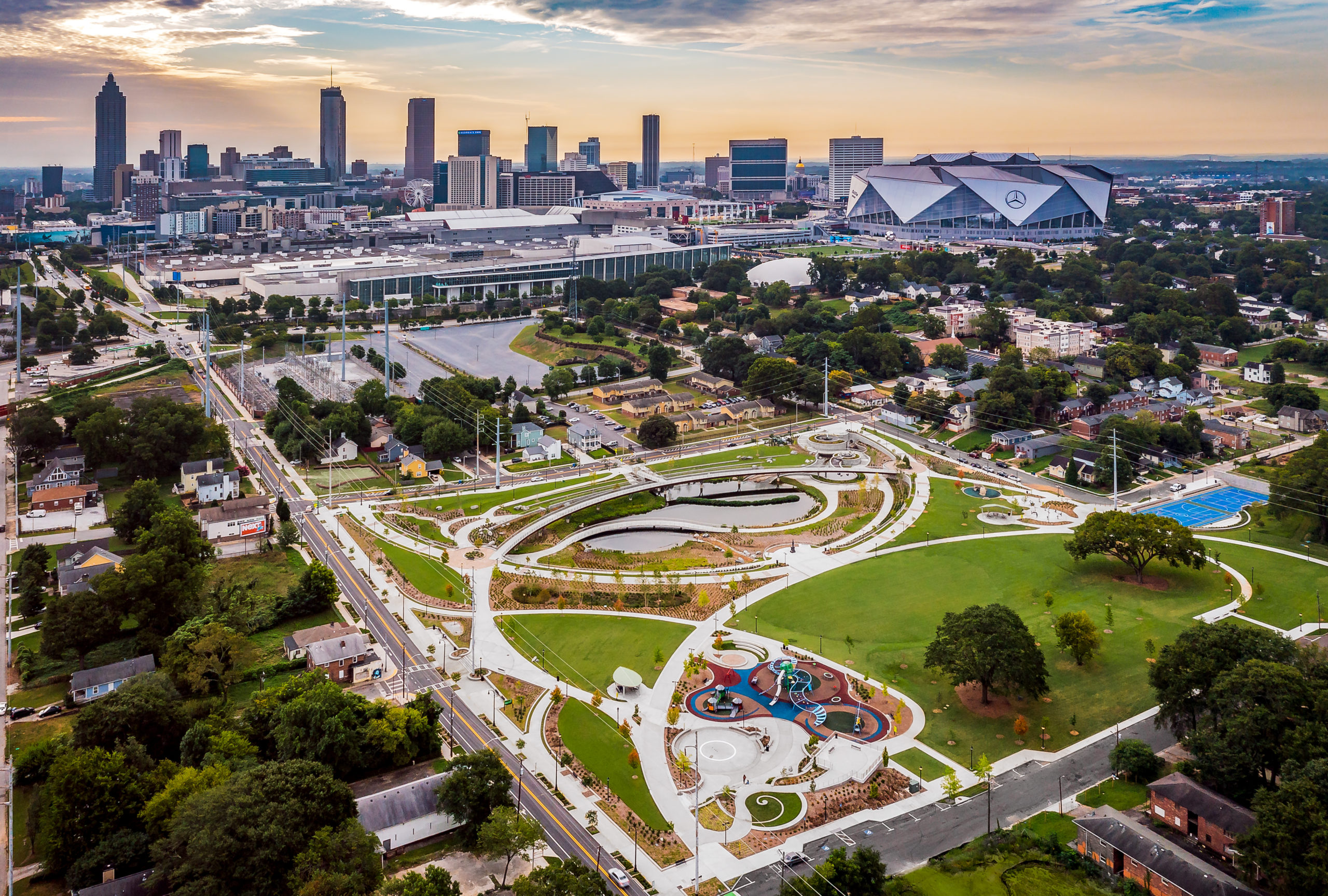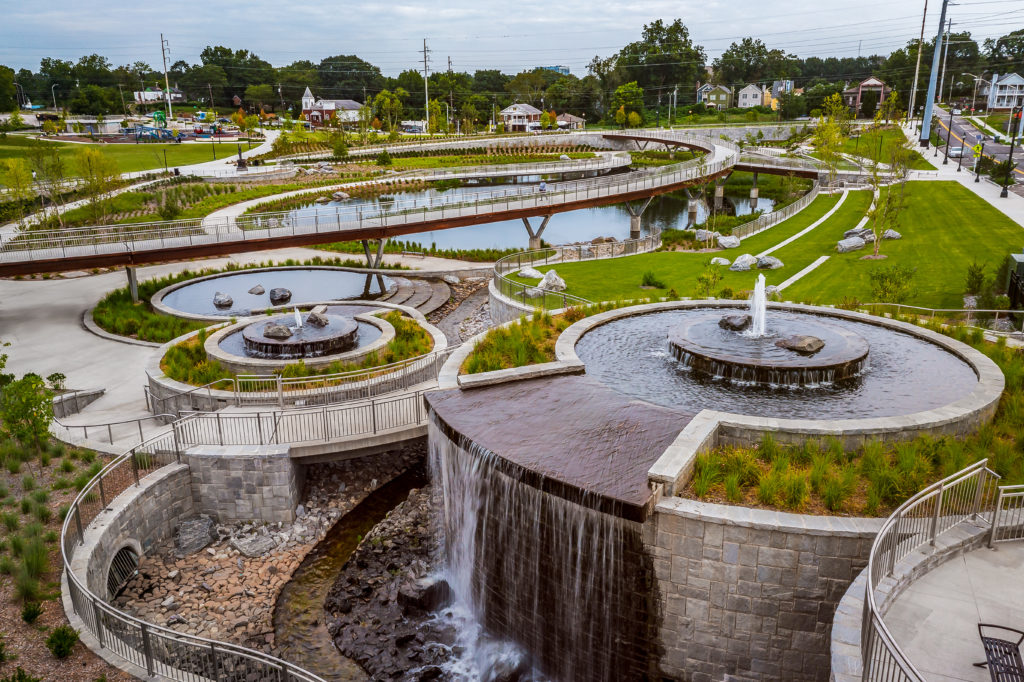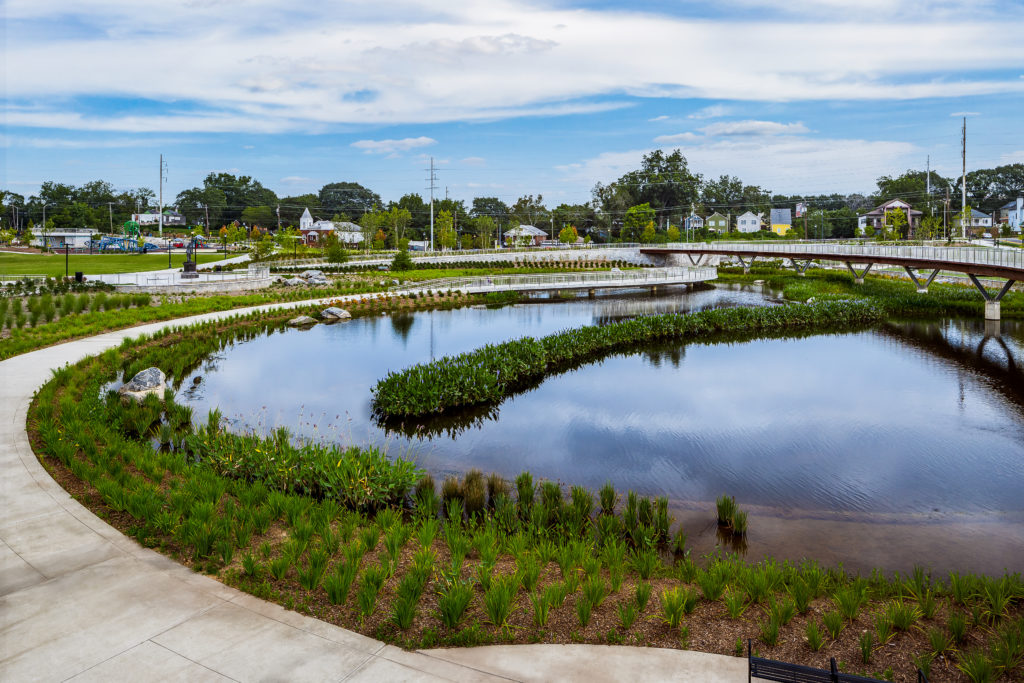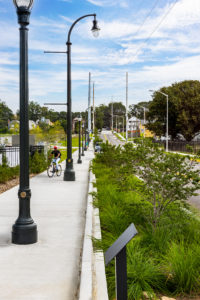Through Multidiscipline Innovations, Cook Park Rejuvenates Atlanta’s Historic Westside

The new $40 million Rodney Cook Sr. Park in Atlanta’s Vine City neighborhood showcases how engineering can improve community health and economic well-being by creating a vibrant green space that doubles as a hard-working instrument to prevent flooding and improve water quality.
The park empowers the Vine City neighborhood — once home to civil rights icons — by transforming 16 acres of empty lots into a welcoming destination that benefits residents and encourages further revitalization. Cook Park combines innovative engineering with acres of amenities, helping to fulfill City goals and applying green infrastructure to tackle long-standing challenges.

Innovation in Stormwater and Multi-Discipline Coordination
The park’s innovative green infrastructure centers around a 2-acre pond surrounded by wetlands, bioretention ponds and stormwater planters. They capture, naturally filter and slowly release stormwater from a 150-acre drainage area to reduce peak loads straining the sewer system. This improves downstream water quality, decreases future capital expenses and lowers maintenance costs.
The design required an array of skills from a multidiscipline Freese and Nichols team across several states. Our role in collaborating with multiple civic stakeholders, park design partner HDR and others demonstrates our ability to provide creative and sustainable infrastructure solutions that help communities thrive.
The project’s visibility, along with the team’s collaborative nature, spotlights a wide range of engineering and design disciplines, including soil and groundwater remediation and protection; civil, geotechnical, structural, systems, hydrology and stormwater engineering; and sustainable infrastructure design.
The History
Sitting west of downtown Atlanta, Vine City has an illustrious history. It once was a thriving community and home to leaders such as the Rev. Martin Luther King Jr. and Maynard Jackson, Atlanta’s first Black mayor. However, the community declined over the years, confronted by poverty, crime and vacant lots.
One of its biggest challenges was protecting homes in the low-lying area from flooding when storms overwhelmed the City’s combined sewer system. In 2002, heavy rains damaged a portion of the neighborhood so extensively that residents were unable to rebuild. The City relocated dozens of families through a FEMA buyout program, but the land sat empty for more than a decade.
Unfortunately, the land and underlying groundwater had been contaminated with lead due to the import of soils used to build up the residential pad sites, complicating redevelopment of the site. Years of discussions and planning led to the concept of Cook Park as both a stormwater solution and sorely needed green space.
The Vision
Vine City residents worked with the City — the Mayor’s Office, Department of Watershed Management, and Parks and Recreation — as well as the Trust for Public Land to create a park that could achieve a range of goals:
- Manage stormwater using sustainable features and natural processes that help clean the water
- Provide a safe, inviting location for daily recreation and large public events
- Separate the combined sewers, reducing the burden on downstream infrastructure and advancing the City’s plan to modernize its entire system
- Create educational opportunities and provide a welcoming setting for large public events
- Revitalize the neighborhood through the investment of public resources to attract new economic development
The Engineering
A multidiscipline team spanning seven Freese and Nichols offices across four states developed the design for the Department of Watershed Management (DWM). The team also led extensive coordination efforts involving multiple consultants and their clients.
To meet DWM’s goals, our design included combined sewer system relief, soil remediation, park development, green infrastructure and 10 million gallons of stormwater detention volume. This was our largest urban water quality project of this kind, both in the volume treated and in the number of stormwater best management practices (BMPs) incorporated. Before designing the pond and surrounding features, FNI developed a stormwater master plan for the 150-acre watershed, including a phased approach for implementation.
HDR, hired by the Trust for Public Land, led design of the park — which features pedestrian bridges and recreational amenities, including a playground, splashpad, basketball court and an expansive lawn space.
Key stormwater management components included: 
- Green infrastructure to improve water quality, including stormwater planters, trash racks, bioretention ponds, and an underground cistern to keep the pond at a normal pool area of 1 acre
- Modeling of an innovative overflow weir using 3D computational fluid dynamics software and integration of the weir with the park design
- New 24- to 60-inch-diameter storm drain piping to convey street drainage to the pond
- Rerouting 1,100 linear feet of 96-inch combined trunk sewer to accommodate the pond grading
The Legacy
While the park is named after the late Rodney Cook Sr., a white legislator who advocated for civil rights in the 1960s, it will honor an array of peacemakers with statues across the park. A 7-foot statue of the late U.S. Rep. John Lewis, who represented Atlanta in Congress, already is on display.
The public education component extends to the stormwater facilities, which the City wanted to use to promote the importance of water quality and show how sustainable infrastructure can improve community resilience.
The innovative design demonstrates how stormwater quantity and water quality issues can be addressed in an integrated way that enhances a public space and educates visitors. For example, street tree planters feature signs explaining how they work, and pond plantings that arc across the water to collect sediment and debris create awareness of how litter impacts waterways.

Rodney Cook Sr. Park shows how collaboration of public and private partners can bring a dream to reality, accomplishing important goals, including:
Transforming empty lots into a gleaming 16-acre urban oasis that embraces the neighborhood’s history, honors peacemakers and serves as a catalyst for further economic development
Protecting the area from flooding, improving water quality through natural filtration, easing strain on the sewer system and implementing the first phase of combined sewer separation
Achieving long-term cost savings by lowering park maintenance costs, reducing peak loads on the City’s treatment plant and improving downstream water quality
Creating a public space that promotes education about Vine City, civic history, culture and the importance of stormwater resilience in helping communities thrive